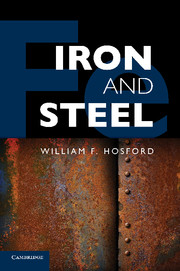Book contents
- Frontmatter
- Contents
- Preface
- 1 General Introduction
- 2 Early History of Iron and Steel
- 3 Modern Steel Making
- 4 Constitution of Carbon Steels
- 5 Plastic Strength
- 6 Annealing
- 7 Deformation Mechanisms and Crystallographic Textures
- 8 Substitutional Solid Solutions
- 9 Interstitial Solid Solutions
- 10 Diffusion
- 11 Strain Aging
- 12 Austenite Transformation
- 13 Hardenability
- 14 Tempering and Surface Hardening
- 15 Low-Carbon Sheet Steel
- 16 Sheet Steel Formability
- 17 Alloy Steels
- 18 Other Steels
- 19 Stainless Steels
- 20 Fracture
- 21 Cast Irons
- 22 Magnetic Behavior of Iron
- 23 Corrosion
- Appendix I Physical Properties of Pure Iron
- Appendix II Approximate Hardness Conversions and Tensile Strengths of Steels
- Index
- References
11 - Strain Aging
Published online by Cambridge University Press: 05 May 2012
- Frontmatter
- Contents
- Preface
- 1 General Introduction
- 2 Early History of Iron and Steel
- 3 Modern Steel Making
- 4 Constitution of Carbon Steels
- 5 Plastic Strength
- 6 Annealing
- 7 Deformation Mechanisms and Crystallographic Textures
- 8 Substitutional Solid Solutions
- 9 Interstitial Solid Solutions
- 10 Diffusion
- 11 Strain Aging
- 12 Austenite Transformation
- 13 Hardenability
- 14 Tempering and Surface Hardening
- 15 Low-Carbon Sheet Steel
- 16 Sheet Steel Formability
- 17 Alloy Steels
- 18 Other Steels
- 19 Stainless Steels
- 20 Fracture
- 21 Cast Irons
- 22 Magnetic Behavior of Iron
- 23 Corrosion
- Appendix I Physical Properties of Pure Iron
- Appendix II Approximate Hardness Conversions and Tensile Strengths of Steels
- Index
- References
Summary
Yielding and Lüders Bands
A tensile stress-strain curve of an annealed low-carbon steel is shown in Figure 11.1. Loading is elastic until an upper yield stress is reached (Point A). Then the load suddenly drops to a lower yield stress (Point B). The reason for this phenomenon is that during annealing, interstitially dissolved carbon and nitrogen atoms tend to diffuse to edge dislocations. Because they partially relieve the stress field around the dislocations (Figure 11.2), they lower the energy. A higher stress is required to break the dislocations free from the interstitial atoms than to move them once they have broken free. Continued elongation after initial yielding occurs by the propagation of the yielded region at this lower yield stress until the entire gauge section has yielded (point C). During this period of yielding, there is a sharp boundary or Lüders band between the region that has yielded and the region that has not. Behind this boundary, all of the material has suffered the same strain. The Lüders strain or yield point elongation in low-carbon steels is typically 1 to 5%. Strain hardening starts only after the Lüders band has traversed the entire gauge section. Finally, at some point, D, the specimen undergoes necking. Figure 11.3 shows Lüders bands that have partially traversed the gauge section.
Strain Aging
If the specimen were unloaded at some point, F, and immediately reloaded, the stress-strain curve would follow the original curve. However, if the unloaded specimen were allowed to strain age, a new yield point would develop (Aʹ). Strain aging would occur if the time was long enough and the temperature were high enough to allow interstitial carbon and nitrogen atoms to diffuse to the dislocations. Figure 11.4 shows that the amount of strain aging increases with the time at room temperature between unloading and reloading.
- Type
- Chapter
- Information
- Iron and Steel , pp. 104 - 112Publisher: Cambridge University PressPrint publication year: 2012



